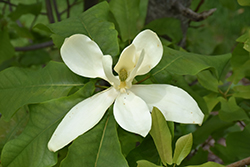It's all about ...
plants

Pyramid Magnolia
Magnolia fraseri x pyramidata
Height: 25 feet
Spread: 10 feet
Sunlight:
![]()
![]()
Hardiness Zone: 8a
Other Names: Magnolia fraseri var. pyramidata
Description:
A slender accent tree for smaller areas, features extremely fragrant star-shaped snow-white flowers in early spring exude a turpentine scent; upright and multi-stemmed with lovely compound foliage that is semi-deciduous
Ornamental Features
Pyramid Magnolia is bathed in stunning fragrant white star-shaped flowers at the ends of the branches from early to late spring. It has green deciduous foliage. The large glossy pointy compound leaves turn coppery-bronze in fall. The fruits are showy pink pods displayed in early fall.
Landscape Attributes
Pyramid Magnolia is a dense deciduous tree with a strong central leader and a distinctive and refined pyramidal form. Its average texture blends into the landscape, but can be balanced by one or two finer or coarser trees or shrubs for an effective composition.
This is a relatively low maintenance tree, and should only be pruned after flowering to avoid removing any of the current season's flowers. Deer don't particularly care for this plant and will usually leave it alone in favor of tastier treats. It has no significant negative characteristics.
Pyramid Magnolia is recommended for the following landscape applications;
- Accent
- Mass Planting
Planting & Growing
Pyramid Magnolia will grow to be about 25 feet tall at maturity, with a spread of 10 feet. It has a low canopy with a typical clearance of 5 feet from the ground, and is suitable for planting under power lines. It grows at a slow rate, and under ideal conditions can be expected to live for 80 years or more.
This tree does best in full sun to partial shade. It requires an evenly moist well-drained soil for optimal growth, but will die in standing water. It is not particular as to soil type, but has a definite preference for acidic soils. It is quite intolerant of urban pollution, therefore inner city or urban streetside plantings are best avoided, and will benefit from being planted in a relatively sheltered location. Consider applying a thick mulch around the root zone in winter to protect it in exposed locations or colder microclimates. This particular variety is an interspecific hybrid.
This plant is not reliably hardy in our region, and certain restrictions may apply; contact the store for more information.
